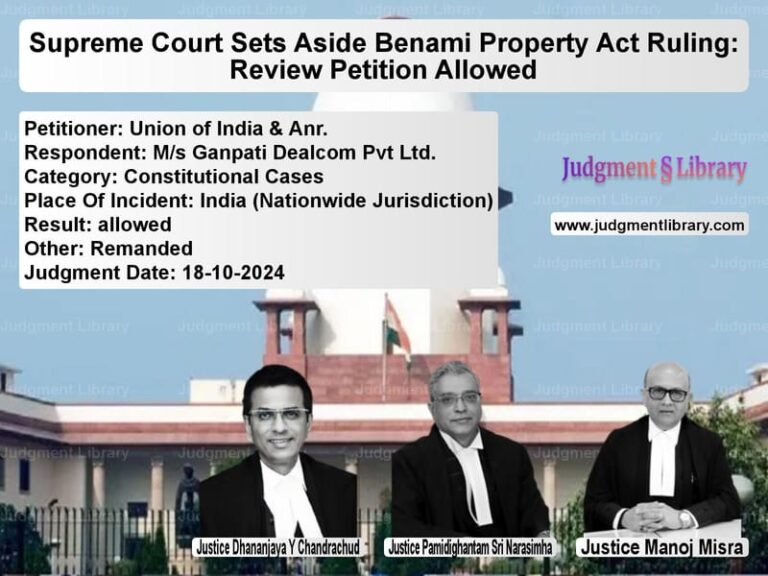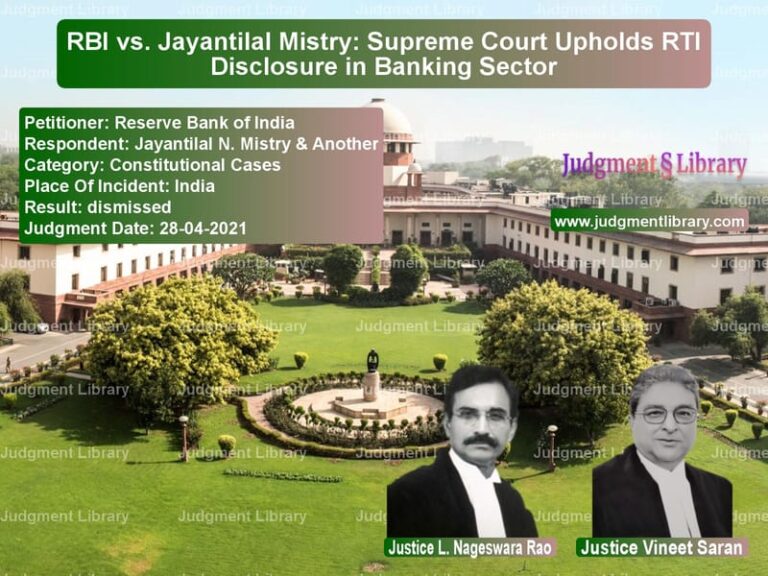Supreme Court Clarifies Section 319 CrPC: No Casual Addition of Accused in Criminal Cases
The Supreme Court of India, in the case of Periyasami & Ors. v. S. Nallasamy, delivered a significant judgment regarding the invocation of Section 319 of the Code of Criminal Procedure (CrPC), which allows the addition of new accused in an ongoing criminal case. The Court ruled that this power should be exercised sparingly and only when strong and cogent evidence exists against the individuals sought to be added as accused.
Background of the Case
The case arose from a dispute between the complainant, S. Nallasamy, and his in-laws. The complainant alleged that on May 5, 2011, his father-in-law, mother-in-law, brother-in-law, wife, and a group of nearly 50 people forcibly entered his house and threatened him with weapons. The complainant further alleged that the group demanded Rs. 30 lakhs as maintenance and threatened to file false dowry cases if he failed to comply.
A First Information Report (FIR) was registered on May 29, 2011, for offenses under Sections 147 (rioting), 448 (house trespass), 294(b) (uttering obscene words), and 506 (criminal intimidation) of the Indian Penal Code (IPC). However, the FIR only named 11 individuals, and the subsequent police investigation did not implicate any additional accused.
Legal Proceedings
Trial Court Decision
The complainant sought further investigation to include 20 additional accused, including several of his in-laws. However, the trial court rejected this request on the grounds that:
- The complainant did not mention the additional accused in his original FIR.
- Even during the police investigation, no other witnesses identified these additional accused.
- The complainant’s attempt to add 20 more individuals seemed to be an afterthought.
- Merely stating the names of people without specifying their exact roles in the crime was insufficient.
High Court Reversal
The complainant appealed to the Madras High Court, which overturned the trial court’s decision. The High Court relied on the testimony of the complainant and a few witnesses, who had later claimed that additional persons were involved in the crime. The High Court ordered that the 20 additional accused be included in the trial.
Supreme Court’s Judgment
The accused challenged the High Court’s order in the Supreme Court, arguing that the complainant had fabricated allegations to falsely implicate his in-laws and their associates. The Supreme Court ruled in favor of the accused, setting aside the High Court’s decision and restoring the trial court’s order. The key observations of the Supreme Court were as follows:
1. Section 319 CrPC Must Be Used Sparingly
The Court reiterated the principle laid down in Hardeep Singh v. State of Punjab (2014) 3 SCC 92 that the power under Section 319 CrPC is discretionary and extraordinary. It should only be invoked when there is strong and cogent evidence against a person who was not originally named as an accused. The Court stated:
“Power under Section 319 CrPC is a discretionary and an extraordinary power. It is to be exercised sparingly and only in those cases where the circumstances so warrant. It is not to be exercised because the Magistrate or the Sessions Judge is of the opinion that some other person may also be guilty of committing that offense.”
2. Mere Mentioning of Names is Not Sufficient
The Supreme Court emphasized that merely stating additional names in a later statement is insufficient. There must be clear evidence linking the individuals to the crime. It held:
“In the First Information Report or in the statements recorded under Section 161 of the Code, the names of the appellants or any other description have not been given so as to identify them. The allegations in the FIR are vague and can be used any time to include any person in the absence of description in the First Information Report.”
3. No Addition of Accused Without Strong Evidence
The Court relied on the case of Labhuji Amratji Thakor v. State of Gujarat (2018), which held that additional accused cannot be summoned without strong evidence. The Court reaffirmed this principle, stating:
“The additional accused cannot be summoned under Section 319 of the Code in a casual and cavalier manner in the absence of strong and cogent evidence.”
4. False Implication in Family Disputes
Given the nature of the dispute, the Supreme Court expressed concerns that family members were being falsely implicated due to matrimonial discord. It held:
“The present case is basically a matrimonial dispute wherein the husband has leveled allegations against the wife and her family members. The complainant has sought to cast a wide net to include numerous other persons without primary evidence of their role in the crime.”
Final Judgment
The Supreme Court allowed the appeal, restored the trial court’s decision, and ruled that the additional accused should not be summoned. The Court concluded:
“Consequently, the order passed by the High Court is set aside and that of the trial court is restored. The application under Section 319 of the Code is dismissed. The appeal is allowed.”
Key Takeaways
- Section 319 CrPC is not to be used lightly: The Court reinforced that this provision is discretionary and should only be exercised when there is clear, strong, and cogent evidence against an individual.
- Mere allegations are insufficient: Simply stating additional names in a later statement does not provide enough grounds for adding accused persons to a trial.
- Protection against false implications: In family disputes, courts must be cautious about false allegations made to drag innocent people into litigation.
- Importance of primary evidence: Courts must rely on primary evidence, such as FIRs and original witness statements, rather than later testimonies that attempt to expand the scope of an accusation.
Conclusion
The Supreme Court’s judgment in Periyasami & Ors. v. S. Nallasamy is a significant ruling that clarifies the application of Section 319 CrPC. The judgment ensures that courts do not allow casual and arbitrary inclusion of accused persons in criminal trials, thereby protecting individuals from baseless prosecutions. This decision sets a crucial precedent for maintaining the fairness and integrity of criminal proceedings.
Petitioner Name: Periyasami & Ors..Respondent Name: S. Nallasamy.Judgment By: Justice Dhananjaya Y Chandrachud, Justice Hemant Gupta.Place Of Incident: Madras, Tamil Nadu.Judgment Date: 14-03-2019.
Don’t miss out on the full details! Download the complete judgment in PDF format below and gain valuable insights instantly!
Download Judgment: Periyasami & Ors. vs S. Nallasamy Supreme Court of India Judgment Dated 14-03-2019.pdf
Direct Downlaod Judgment: Direct downlaod this Judgment
See all petitions in Bail and Anticipatory Bail
See all petitions in Judgment by Dhananjaya Y Chandrachud
See all petitions in Judgment by Hemant Gupta
See all petitions in allowed
See all petitions in supreme court of India judgments March 2019
See all petitions in 2019 judgments
See all posts in Criminal Cases Category
See all allowed petitions in Criminal Cases Category
See all Dismissed petitions in Criminal Cases Category
See all partially allowed petitions in Criminal Cases Category







